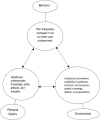The views of patients, healthcare professionals and hospital officials on barriers to and facilitators of quality pain management in Ethiopian hospitals: A qualitative study
- PMID: 30870467
- PMCID: PMC6417681
- DOI: 10.1371/journal.pone.0213644
The views of patients, healthcare professionals and hospital officials on barriers to and facilitators of quality pain management in Ethiopian hospitals: A qualitative study
Abstract
Background: Postoperative pain remains a challenge in the developed world, but the consequences of inadequately treated postoperative pain are particularly severe in low- and middle-income countries. Since 2011, reports have drawn attention to the poor quality of postoperative pain management in Ethiopia; however, our multicenter qualitative study was the first to attempt to understand the factors that are barriers to and facilitators of quality pain managment in the country. To this aim, the study explored the perspectives of patients, healthcare professionals, and hospital officials. We expected that the results of this study would inform strategies to improve the provision of quality pain management in Ethiopia and perhaps even in other low- and middle-income countries.
Methods: This study used a qualitative, descriptive approach in which nine healthcare professionals, nine patients, and six hospital officials (i.e. executives in a managerial or leadership position in administration, nursing, or education) participated in face-to-face, semi-structured interviews. Thematic data analysis was conducted, and patterns were explained with the help of a theoretical framework.
Findings: The barriers identified ranged from healthcare professionals' lack of empathy to a positive social appraisal of patients' ability to cope with pain. They also included a lack of emphasis on pain and its management during early medical education, together with the absence of available resources. Enhancing the ability of healthcare professionals to create favorable rapport with patients and increasing the cultural competence of professionals are essential ingredients of future pain education interventions.
Conclusions: Barriers to and facilitators of postoperative pain management do not exist independently but are reciprocally linked. This finding calls for holistic and inclusive interventions targeting healthcare professionals, patients, and hospital officials. The current situation is unlikely to improve if only healthcare professionals are educated about pain physiology, pharmacology, and management. Patients should also be educated, and the hospital environment should be modified to provide high-quality postoperative pain management.
Conflict of interest statement
The authors have declared that no competing interests exist.
Figures
Similar articles
-
Healthcare professionals' perspectives on barriers and facilitators to implementing a warning signs intervention for older rural-dwelling medical patients at risk for hospital readmission.PLoS One. 2025 May 5;20(5):e0322138. doi: 10.1371/journal.pone.0322138. eCollection 2025. PLoS One. 2025. PMID: 40323972 Free PMC article.
-
Barriers to Pediatric Postoperative Pain Management-Interprofessional Focus Group Interviews.Pain Manag Nurs. 2025 Apr;26(2):e117-e123. doi: 10.1016/j.pmn.2024.11.001. Epub 2024 Dec 10. Pain Manag Nurs. 2025. PMID: 39665959
-
Barriers and facilitators in providing care for patients with a migration background.J Clin Nurs. 2023 Mar;32(5-6):912-925. doi: 10.1111/jocn.16491. Epub 2022 Aug 15. J Clin Nurs. 2023. PMID: 35968776
-
A mixed-methods systematic review and meta-analysis of barriers and facilitators to paediatric symptom management at end of life.Palliat Med. 2020 Jun;34(6):689-707. doi: 10.1177/0269216320907065. Epub 2020 Mar 31. Palliat Med. 2020. PMID: 32228216 Free PMC article.
-
Barriers and facilitators to health professionals' engagement in quality improvement initiatives: a mixed-methods systematic review.Int J Qual Health Care. 2024 May 21;36(2):mzae041. doi: 10.1093/intqhc/mzae041. Int J Qual Health Care. 2024. PMID: 38727534
Cited by
-
Modifiable factors associated with a consistently high acute pain trajectory after surgical treatment of traumatic fractures in Ethiopia: a multi-center prospective cohort study.J Orthop Surg Res. 2023 Apr 10;18(1):288. doi: 10.1186/s13018-023-03770-0. J Orthop Surg Res. 2023. PMID: 37038171 Free PMC article.
-
Availability and Use of Essential Opioid Analgesics in Sub-Saharan Africa: A Scoping Review Protocol.Int J Surg Protoc. 2023 Feb 1;27(1):1-8. doi: 10.29337/ijsp.184. eCollection 2023. Int J Surg Protoc. 2023. PMID: 36789102 Free PMC article.
-
Voices of surgical wards nurses on barriers hindering acute post-operative pain management at Tshwane municipality, South Africa.PLoS One. 2025 Feb 21;20(2):e0316809. doi: 10.1371/journal.pone.0316809. eCollection 2025. PLoS One. 2025. PMID: 39982877 Free PMC article.
-
Prevalence and Risk Factors for Acute Postoperative Pain After Elective Orthopedic and General Surgery at a Tertiary Referral Hospital in Tanzania.J Pain Res. 2020 Nov 19;13:3005-3011. doi: 10.2147/JPR.S258954. eCollection 2020. J Pain Res. 2020. PMID: 33244259 Free PMC article.
-
A Bibliometric Analysis of Published Literature in Postoperative Pain in Elderly Patients in Low- and Middle-Income Countries.J Clin Med. 2021 May 27;10(11):2334. doi: 10.3390/jcm10112334. J Clin Med. 2021. PMID: 34071737 Free PMC article. Review.
References
Publication types
MeSH terms
Substances
LinkOut - more resources
Full Text Sources
Medical



